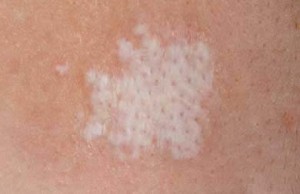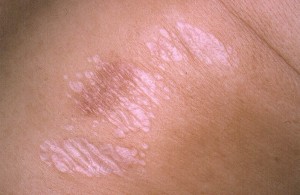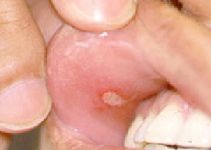Are you suffering from smooth white patches that have suddenly appeared on your genital or anal area? You might be suffering from a disease called Lichen sclerosus (LS). Read and know all about the condition, including its causes, symptoms, diagnosis and treatment options.
What is Lichen sclerosus?
Page Contents
- 1 What is Lichen sclerosus?
- 2 Lichen sclerosus ICD 9 Code
- 3 Lichen sclerosus Incidence
- 4 Lichen sclerosus Causes
- 5 Who Gets Lichen sclerosus?
- 6 Lichen sclerosus Symptoms
- 7 Lichen sclerosus Diagnosis
- 8 Lichen sclerosus Differential Diagnosis
- 9 Lichen sclerosus Treatment
- 10 Lichen sclerosus Risk Factors
- 11 Lichen sclerosus Complications
- 12 Lichen sclerosus Prognosis
- 13 Does Lichen sclerosus Go Away?
- 14 Lichen sclerosus Support Groups
- 15 Lichen sclerosus Pictures
It is an uncommon disorder characterized by patches of white skin that are thinner in shape than usual skin patches. In males, the condition was earlier referred to as “Balanitis xerotica obliterans.”
The disease is also known as “Lichen sclerosus et atrophicus.”
Lichen sclerosus ICD 9 Code
The ICD 9 Code for this disease is 701.0.
Lichen sclerosus Incidence
Although it may develop at any age, middle-aged are commonly found to suffer from the problem. The disease affects approximately one of out every thousand women. However, as its exact prevalence is unreported, it may be even more common than this statistics suggests.
Lichen sclerosus Causes
Medical researchers and doctors are still baffled regarding the exact cause of this disease. The condition is believed to be associated to an overactive immune system or a sex hormone-deficiency in the affected areas of the skin. Damage to a particular region of the skin in the past may elevate the risk of LS in that spot.
Heredity is also believed to be responsible for this condition as some people are suspected to inherit it from their parents. However, a genetic association has not been definitely proven.
Four other factors are believed to be responsible for this disease:
Infections
Viral as well as bacterial pathogens are believed to have a role in the development of this disorder. Hepatitis C, spirochete Borrelia burgdorferi and HPV are suspected to be causative agents for the disease.
Local changes in skin
As per certain research findings, the disorder may result from radiation or scarring. However, such findings are uncommon and quite sporadic in nature, which makes it impossible for researchers to rely on them.
Who Gets Lichen sclerosus?
The condition affects postmenopausal women most frequently. However, men and children may also get affected by this disorder. In females, the condition generally affects the vulva. Among males, uncircumcised men are most susceptible as the disease usually impacts the foreskin. In children, the symptoms may show an improvement at the time of puberty. However, the condition is uncommon in males. It arises only rarely in children.
Lichen sclerosus Symptoms
The condition may affect any region of the skin. In the majority of cases, however, it is found to impact:
- The skin of the vulva
- The skin surrounding the anus
- The foreskin of the penis
In some cases, patients are found to be asymptomatic. In other words, they do not exhibit any signs or symptoms associated to this condition. This is particularly true of mild cases. However, in cases where symptoms are apparent, the following problems can be experienced:
- Itching, possibly of severe type
- Tendency of the skin to tear or bruise easily
- Discomfort, which is usually severer if the skin around the anal or genital region is affected
- Pain during intercourse
- Progression of smooth white skin spots into wrinkled, blotchy patches
- Blistering, bleeding or ulceration of lesions in acute cases
In the early stages, the disorder is manifested by small white spots over the affected areas of the skin. These spots are generally smooth and shiny to look at. In the later phases, these develop into bigger patches. The skin overlying them becomes thin and wrinkled in appearance and tears easily. Purple or bright red bruising of the skin is also common. In some cases, the skin gets scarred.
Patients should seek professional medical care from a doctor in case of one or more of the above-mentioned symptoms. Effective curative options are available to aid in the management of discomforting sensations as well as in the prevention of complications.
Lichen sclerosus Diagnosis
The condition is diagnosed and confirmed by physicians on the basis of a physical exam and biopsy. In the latter process, a small section of the affected tissue is removed and put through a microscopic examination. A biopsy helps physicians make sure that the symptoms experienced by sufferers are not the result of some other disorder.
Lichen sclerosus Differential Diagnosis
The differential diagnosis for this disorder involves distinguishing it from other conditions of the skin, mucosa and genital. These include:
- Bowen’s disease
- Graft-versus-host disease
- Localised scleroderma
- Lichen planus
- Leukoplakia
- Vitiligo
- Vulval intraepithelial neoplasia
Lichen sclerosus Treatment
Treatment for this condition might be unnecessary as the condition often improves without any professional medical care. Patients may not require treatment if the genital region is unaffected, and in case of absence of symptoms. However, symptomatic cases the disorder might result in other complications if left without treatment. Due to this reason, a visit to doctor is recommended. In case treatment is necessary, a physician may recommend medical options that may help restore normal appearance of the skin as well as reduce the risk of scarring. Treatment also aims at reducing itchiness, which is one of the major issues associated with this disease.
Corticosteroids
Creams and ointments with a corticosteroid base are often prescribed to patients of Lichen sclerosus. In the initial stages of treatment, daily topical application of such creams is necessary. A few weeks afterwards, patients are recommended to use the drugs for two times a week to prevent a recurrence of the disorder. However, physicians need to monitor patients using corticosteroid creams as long-term use of these substances lead to problems like thinning of the skin. Topical steroids, such as Clobetasol propionate, may alleviate the discomforting symptoms and prevent risk of scarring.
If corticosteroid medications fail to yield effective results, other options curative might be considered. These include:
Immune-modulating medicines
Pimecrolimus (Elidel) and Tacrolimus (Protopic) might give positive results in alleviating the symptoms of the disease.
Ultraviolet light treatment
This type of therapy is found to be useful for non-genital regions.
Topical sex hormones
These are prescribed only in certain cases. As per recent researches, however, such drugs are not as effective in curing the condition as the treatment options mentioned above.
Antibiotics
According to a recent study, prolonged treatment with antibiotic medications has been found to yield effective results in all affected individuals. This type of treatment shows quite beneficial response in a few weeks.
Circumcision (Removal of foreskin)
In uncircumcised men affected by LS on the foreskin, circumcision is a common treatment option. This is particularly advised in advanced cases or cases that are resistant to other types of therapies.
Surgery
Operative cure for the anal or genital region is not usually recommended for women affected with this disorder. This is due to the fact that the condition shows a recurrence after operation.
Other treatment options
Recent studies suggest that injecting stem cells and Platelet-rich plasma (PRP) into the affected regions may decrease discomforts and improve the status of the lesions.
Lichen sclerosus Risk Factors
There are no particular risk factors associated to this disease. However, postmenopausal women are believed to be most susceptible to this condition.
Lichen sclerosus Complications
Acute cases of this disease can result in itching and scarring. This may lead to a narrowing of the vaginal aperture (opening) and make intercourse very painful for suffering women. Moreover, blistering may heighten the sensitivity of the skin to such an extent as to make the slightest pressure on the region unbearable for patients.
As the problem leads to a thinning and tightening of the foreskin, it may result in same type of complications in men who are uncircumcised. These may lead to problems during urination or erection.
The condition has been associated with an elevated risk of cancer. Persistence of the condition in a single region is believed to increase the risk of skin cancer slightly. However, this has not been proved conclusively. Due to this reason, patients must go through follow-up examinations after every 6-12 months. A skin region scarred by LS is more susceptible to cancer. Females affected by this disease may suffer from vulvar carcinoma. Hence, consultation is required periodically. In follow-up visits, physicians can look at the appearance of skin and treat changes (if any).
The disorder can also have a negative impact on the psychology of its patients. As per statements from the National Vulvodynia Association, vulvo-vaginal conditions may give rise to pscychological problems like hopelessness, negative image of self, and isolation. Some female sufferers might be incapable of maintaining sexual relationships or continuing with their professional career. Their normal physical activities may also be affected. Along with painful symptoms, sufferers can also experience anxiety, depression and even anger due to the disease.
Although the disorder may involve the skin region surrounding the genitals, it is fortunately non-contagious and cannot spread through sexual intercourse.
Lichen sclerosus Prognosis
The condition can persist for a long duration. In some cases, especially in young girls, it may get resolved spontaneously.
Does Lichen sclerosus Go Away?
Although the condition is not permanently curable, using a topical steroid can help alleviate the discomforting symptoms like itchiness and soreness. As aforesaid, the condition often resolves spontaneously. This is truer in case of young girls at the time of puberty.
Lichen sclerosus Support Groups
People affected with this disease may seek support and obtain information from reputed health institutes.. You may enquire about the disease, or the safety of any of the medications you are having as a remedy for this condition, from the following organizations:
National Institute of Arthritis and Musculoskeletal and Skin Diseases (NIAMS)
Information Clearinghouse
National Institutes of Health
1 AMS Circle
Bethesda, MD 20892-3675
Phone: 301-495-4484
Toll Free: 877-22-NIAMS (877-226-4267)
TTY: 301-565-2966
Fax: 301-718-6366
Email: [email protected]
Website: http://www.niams.nih.gov
U.S. Food and Drug Administration
Toll Free: 888–INFO–FDA (888–463–6332)
Website: http://www.fda.gov
Lichen sclerosus Pictures
Check out the following images to understand how the condition affects the physical appearance of its sufferers.
Picture 1 – Lichen sclerosus
Picture 2 – Lichen sclerosus Image
If you are suffering from this discomforting skin disorder, get in touch with a doctor for effective and faster recovery. In case you have already been diagnosed with the condition, visit your physician after every 6-12 months to ensure the absence of any side effects of treatment or any abnormal changes in your skin appearance.
References:
http://www.mayoclinic.com/health/lichen-sclerosus/DS00725
http://www.niams.nih.gov/health_info/lichen_sclerosus/
http://emedicine.medscape.com/article/1123316-overview
http://www.patient.co.uk/doctor/Lichen-Sclerosus.htm



